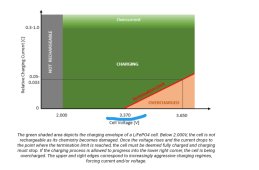Thanks, yes i know the job of a balancer has nothing to do with capacity but concerns only voltage.
Why i measured and mentioned it has following reason.
As you know for especially lifepo4s voltage and capacity doesn't behave linear. For example a difference of 56mV (3.4V to 3.456V = 56mV) has a different significance depending where you are on the charging curve (at 0.07C discharge current, it is 50%capacity in some curve areas according to my testing). So i wanted to put my deviated (from what i ordered and was confirmed before ordering) switch ON and OFF voltage points in perspective. Is the difference from 3.4V (or 3.43V since that is the number they tested in their lab and shared with me before ordering) to 3.456V significant or not was my question. Should i be concerned or not since the deviation is higher than the 50mV they stated before? 3.43V (what they said they tested in the lab) would have been within the promised 50mV tolerance. 3.456V (56mV) was already outside but let's say that is still fine because my voltmeter has an 0.5% error at a scale of 0.001V. 3.311V (89mV) was way out of tolerance. So after testing of how much difference it makes in relation to capacity i thought, well never mind, i can live with a +-2%capacity tolerance (it will be of course more or less if i would reduce or increase the charge or discharge rating), not worth the trouble of complaining. Overall although not perfect this customized balancer is already way better, more suitable for me than the stock version. Of course i would also have preferred if it would have switched on at 3.4v or even 3.43v. 3.456V is indeed borderlining but still usable since i know it and can adapt to it.
So I just shared the numbers of whatever i tested, the 4% was just an information for those who also have questions like me above.
Sure everyone has a different system, different charging end points, different demands etc so i understand judging from your final charge voltage of 13.9V, 3.45V is too high since there could be instances where the balancer wouldn't even turn on which would render it a useless accessory.
After all this customized version is their first try, a prototype, maybe they will improve it and then bring it eventually on the market. If they want to commercialize it, switch ON should be at 3.4V (or little bit less), switch off at 3.3V (or little bit more). that would cater most demands and charging profiles. I already gave them a feedback and a recommendation for a commercial special version for Lifepo4 batteries in solar systems. Switch on at 3.4V (or little bit lower), switch off at 3.3V (or little bit higher).



